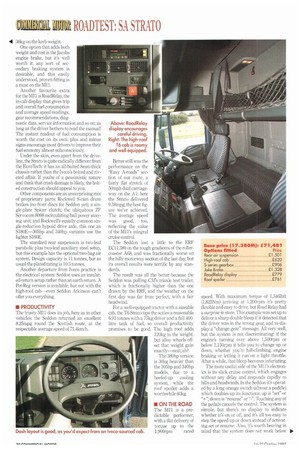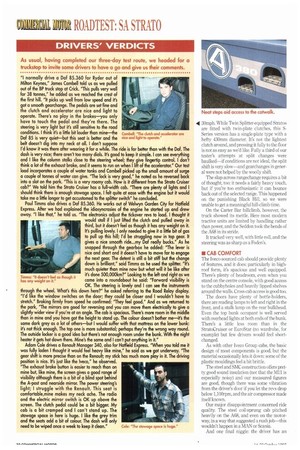OUT OF
Page 30

Page 32

Page 34

Page 35

If you've noticed an error in this article please click here to report it so we can fix it.
OLDHAM
If you want the predictability of a Cummins/Eaton/Rockwell driveline matched to the advanced cab design of a continental tractive unit, then Seddon Atkinson might have just the truck for you. Today Oldham...tomorrow the world?
0 h no—not another one! This is the umpteenth Cummins-powered tractive unit we've driven this year. We tested another Seddon Atkinson with a near-identical driveline just four months ago. So why on earth are we testing another one?
Well, the chassis manufacturers who buy in engines have come to regard Cummins' Mll engine as a safe bet: every Euro-2 version we've tested has performed well, producing some of our best-ever fuel consumption figures round the Scottish route—and an ERF EC11.38 currently holds the 38-tonne record.
Understandably, other manufacturers are keen to show that they can offer comparable performance and economy. Seddon Atkinson has long used Cummins power, so the M380E (the 380hp variant of the M11) is an obvious
choice this level of power is rapidly becoming the fleet norm at 38 tonnes. But it would be nice to come up with some lousy results for a change!
• PRODUCT PROFILE
The last 380hp Seddon that CM tested was the StratoCruiser version, with what SA calls the T7 cab—it's the big volume EuroStar cab from parent company Iveco. This one is a Straw T6, which uses the smaller EuroTech cab, in this case with the option of a high roof.
The tall cab is not too dear, adding just £620 to the cost of a normal sleeper cab. If you're sure to be hauling full-height trailers all the time the 3.98m-tall high-roof version looks like a good buy The T6 is less spacious and luxurious than the T7 and it costs around £2,600 less, but it's hardly spartan: standard features include electric windows, heated mirrors, fog and spot lamps and a roof hatch. Inside, you get an airsuspended driver's seat, twin bunks, a radio/cassette unit and a night heater—all essential for most drivers, but surprisingly options—and expensive ones—on some competitors' tractive units.
Still, Seddon is in the business of giving the customer what he wants. Like Foden and ERF, the Oldham firm believes the customer is always right, so plenty of options are available. The standard Eaton Twin Splitter gearbox can be replaced with the S-Series 16-speed synchromesh type, which has a 0.83:1 overdrive top ratio rather than direct drive. This costs a fair bit but it actually saves 10 36kg on the kerb weight.
One option that adds both weight and cost is the Jacobs engine brake, but its well worth it: any sort of secondary braking system is desirable, and this easily understood, proven fitting is a must on the M11.
Another favourite extra for the MI I is RoadRelay, the in-cab display that gives trip and overall fuel consumption and average speed readings, gear recommendations, diagnostic data, service information and so on; as long as the driver bothers to read the manual! The instant readout of fuel consumption is worth the cost on its own: plus and minus signs encourage most drivers to improve their fuel economy almost subconsciously.
Under the skin, even apart from the driveline, the Strato is quite radically different from the EuroTech; it has an all-bolted 8mm-thick chassis rather than the lveco's bolted and riveted affair. If you're of a pessimistic nature and think that crash damage is likely, the bolted construction should appeal to you.
Other components are an unsurprising mix of proprietary parts: Rockwell S-cam drum brakes (no front discs for Seddon yet); a single-plate Spicer clutch; the ubiquitous ZF Servocom 8098 recirculating-ball power steering unit: and Rockwell's equally common single-reduction hypoid drive axle, this one an S180E-305hp and 340hp variants use the lighter S160E.
The standard rear suspension is two-leaf parabolic plus two-leaf auxiliary steel setup, but this example has the optional two-bag air system. Design capacity is 11 tonnes, but as usual the plated rating is 10.5 tonnes.
Another departure from lveco practice is the electrical system: Seddon uses an insulated-return setup rather than an earth return. A Pet-Reg version is available, but not with the high-roof cab—even Seddon Atkinson can't offer you everything.
• PRODUCTIVITY The trusty M1 1 does its job, here as in other vehicles: the Seddon returned an excellent 8.25mpg round the Scottish route, at the respectable average speed of 71.4km/h. Better still was the performance on the "Easy A-roads" section of our route, a fairly flat stretch of 50mph dual carriageway on the Al: here the Strato delivered 9.38mpg, the best figure we've achieved. The average speed was good, too, reflecting the value of the Mils integral cruise control.
The Seddon lost a little to the ERF EC11.380 on the tough gradients of the rollercoaster A68, and was fractionally worse on the hilly motorway section of the last day, but its overall results were terrific by any standards.
The result was all the better because the Seddon was pulling CM's triaxle test trailer, which is fractionally higher than the one drawn by the ERF, and the weather on the first day was far from perfect, with a fair headwind.
For a well-equipped tractor with a sizeable cab, the T6 Strato tips the scales a reasonable 6.93 tonnes with a 75kg driver and a full 400litre tank of fuel, so overall productivity promises to be good. The high roof adds 120kg to the weight, but alloy wheels offset that weight gain exactly—neat, eh?
The 380hp version is 30kg heavier than the 305hp and 340hp models, due to a beefed-up cooling system, while the roof spoiler adds a worthwhile 60kg.
• ON THE ROAD The M1 1 is a predictable performer, with a flat delivery of torque up to the 1,900rpm rated speed. With maximum torque of 1,346Ibft (1,825Nm) arriving at 1,200rpm it's pretty flexible and easy to drive, but Road Relay had a surprise in store. This example was set up to deliver a sharp double bleep if it detected that the driver was in the wrong gear, and to display a "change gear" message. All very well, but the system is not discriminating: if the engine's turning over above 1.500rpm or below 1,150rpm it tells you to change up or down, whether you're hill-climbing, engine braking or letting it run on a light throttle. After a while, that bleep becomes infuriating The more useful side of the M1 l's electronics is its slick cruise control, which engages without any delay and responds rapidly to hills and headwinds. ln the Seddon it's operated by a long orange switch (almost a paddle) which doubles up its functions: up is "set" or "+'"; down is "resume" or "-". Touching any of the pedals cancels the control. The system is simple, but there's no display to indicate whether it's on or off, and it's all too easy to step the speed up or down instead of activating set or resume. Also, it's worth bearing in mind that the system does not work below 11111. • 30mph. While Twin Splitter-equipped Stratos are fitted with twin-plate clutches, this SSeries version has a single-plate type with a hefty 430mm diameter. It's not the lightest clutch around, and pressing it fully to the floor is not as easy as we'd like. Fully a third of our tester's attempts at split changes were baulked—if conditions are not ideal, the split shift is very slow—and gearchanges in general were not helped by the woolly shift.
The slap7across rangechange requires a bit of thought, too: it needs a fairly heavy touch, but if you're too enthusiastic it can bounce back out of the selected range. This happened on the punishing Black Hill, so we were unable to get a meaningful hill-climb time.
On the Carter Bar hillclimb, however, the truck showed its mettle. Here most modern tractive units are limited by handling rather than power, and the Seddon took the bends of the A68 in its stride.
It tracked very well, with little roll, and the steering was as sharp as a Foden's.
• CAB COMFORT The Iveco-sourced cab should provide plenty of features, and it does: particularly in highroof form, it's spacious and well equipped. There's plenty of headroom, even when you stand on the centre console, with good access to the cubbyholes and heavily lipped shelves around the walls. Cross-cab access is good kick The doors have plenty of bottle-holders, there are reading lamps to left and right in the front, and a stalk lamp on the rear bulkhead. Even the top bunk occupant is well served with overhead lights at both ends of the bunk. There's a little less room than in the StratoCruiser or EuroStar (no wardrobe, for example) but few drivers would feel shortchanged.
As with other Iveco Group cabs, the basic design of most components is good, but the material occasionally lets it down: some of the plastic mouldings feel a bit brittle.
The steel and SMC construction offers pretty good sound insulation (not that the Mll is especially noisy) and our measured figures are good, though there was some vibration from the driver's door if you let the revs drop below 1,100rpm, and the air compressor made itself known.
Our major disappointment concerned ride quality. The steel coil-sprung cab pitched heavily on the A68, and even on the motorway, in a way that suggested a rush job—this wouldn't happen in a MAN or Scania.
And one final niggle: the driver has an
excellent safety belt built into the seat, but the passenger has no seatbelt at all. Details, details...
• SUMMARY No luck, then-we were unable to coax poor fuel consumption out of the M11! Instead we recorded the usual exemplary figures and the usual straightforward drive. The payload is good and the average speeds are fine, The Cummins engine has consolidated its position as a reliably economical powerplant.
But, like other Seddons we've tested, the ride could have been better, and the gearshift slicker. It's details like these that belie the Strato's continental appearance, but they won't put off the Seddon fan or the operator who likes a made-to-measure truck.
111 by Toby Clark




















































































































